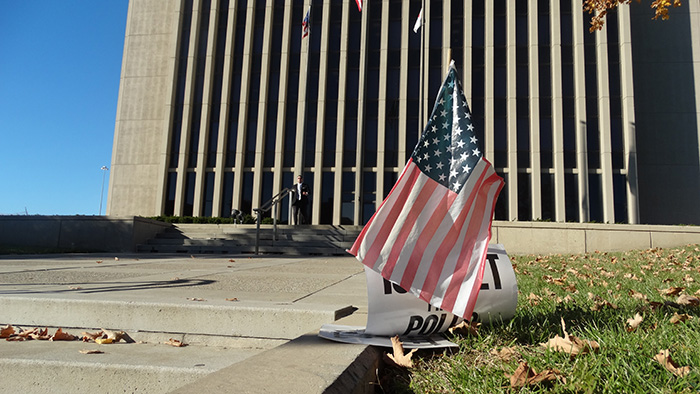 The votes poured in the evening of November 3, passing Issue 1 and Issue 2, but leaving Issue 3—marijuana legalization—defeated.
The votes poured in the evening of November 3, passing Issue 1 and Issue 2, but leaving Issue 3—marijuana legalization—defeated.
Sinclair’s 1-mill property tax levy also passed, but at close margins, 54 percent to 46. Sinclair has plans to consolidate the health programs into one building as well as to continue to provide education for in-demand professions. The campaign posters often read “Sinclair for Good Jobs” and “Sinclair for Our Future.”
Issue 1, having passed in a landslide victory, will require minority party membership on the panel that will redraw legislative boundaries during the next redistricting process in 2021. Further stipulations require at least two minority party votes for any map for state legislative districts, as well as a majority. These maps are redrawn every ten years, in accordance with the census. Issue 1 received tremendous bipartisan support. Issue 1’s passing may provide additional transparency to the redistricting process, requiring three public meetings before any decision can be made by the panel.
 That is a departure from the current process, which has heavily relied on political consultants and left little public documentation. The current process also largely obscures the voice of the people, having not included avenues like public meetings for concerned parties to express those sentiments. With a proper, public record, the judicial process for prosecuting and proving incidents of Gerrymandering, or the deliberate drawing of legislative lines for political gain, is simplified.
That is a departure from the current process, which has heavily relied on political consultants and left little public documentation. The current process also largely obscures the voice of the people, having not included avenues like public meetings for concerned parties to express those sentiments. With a proper, public record, the judicial process for prosecuting and proving incidents of Gerrymandering, or the deliberate drawing of legislative lines for political gain, is simplified.
The process in 2011, when the maps were last redrawn, has only required a majority of votes in approval for the lines to be finalized. This process has long faced public scrutiny, particularly with cases where these decisions were reached by boards consisting of four members of the majority party and one of the minority. Both the Ohio Republican Party and the Ohio Democratic Party endorsed Issue 1. The legislation does not currently extend to modify congressional district lines.
Issue 2, popularly considered the “anti-monopoly” issue passed by fewer than 100,000 votes at roughly 51 percent to 48 percent. The passing of the issue will ensure that a “monopoly, oligopoly or cartel,” like that which is detailed in Issue 3, will never be attached to the state of Ohio’s constitution. Issue 2 received public support from large organizations like the Chambers of Commerce, whereas opponents of the Issue were ResponsibleOhio, The Libertarian Party of Ohio and the Green Party of Ohio to list a few. Fewer than half of states in the US have similar legislation prohibiting monopolies.
Issue 3, the full legalization of marijuana, was struck down at 64 percent opposed and only 34 percent in favor. The amendment to the State Constitution would have legalized the limited sale and use of marijuana as well as create only 10 facilities with exclusive commercial rights to grow marijuana. The finer text, particularly the guarantee of exclusive rights to limited persons, evoked such a strong reaction that not only was Issue 2 formed, but nearly two thirds of voters opposed the legislation. Since the days of which Theodore Roosevelt busted up monopolies, even while popular opinion on the complete legalization or illegalization of medical marijuana is a strong polling topic for voters across the nation, Issue 3 went up in flames.
Persons of interest like former 98 Degrees singer Nick Lachey, were to be investors in each Marijuana Growth, Cultivation and Extraction facility. The involvement of the well-off in an oligarchy on marijuana has turned away many who otherwise state their support for legalization—just without the economic stipulations.
Other factors, like average voter turnout on off-year election, resulted in Ohio saying “no thanks” to marijuana for the year. On this off-year election, Ohio’s voter turnout was around 42 percent. On an even-year, a presidential election year, turnout is above 70 percent. ResponsibleOhio is the group that fought for Issue 3’s passing. Marijuana legalization supporters face hurdles like cultural differences for recreational substance use. Ohio is not the California of the Midwest, as reflected by this year’s election results.
ResponsibleOhio’s mascot, Buddie, also came off to some as an appeal to children. Commercials for Issue 2 often included a tag line, “No to marijuana candy” as there was measurable concern that the legalization would lead to baked goods and other products being consumed by children instead of those over 21, the requirement by law that Issue 3 would have required for persons to smoke or ingest marijuana.
“Tonight’s vote is a resounding statement that Ohioans do not support the enshrinement of marijuana cartels in Ohio’s constitution,” said Ohio Attorney General Mike DeWine. “Tonight is a great victory for Ohio’s families, public safety and the democratic process.”
Draws to Issue 3 were the projected tax revenue—a 15 percent flat tax—as well as the benefits to medicinal marijuana use and cost of incarceration for nonviolent offenders. However, Presidential Candidate John Kasich shared his own response, “We’re running a $2 billion surplus, we’re not having a revenue problem right now. And sending mixed signals to kids about drugs is a disaster,” Kasich said.
ResponsibleOhio may be down, but they’re not out for the count. ResponsibleOhio will still campaign, just differently.
“We trust the voters. We started the conversation, and we’re going to continue the conversation starting tomorrow. The status quo doesn’t work, it’s unacceptable and we’re not going away. All the things we’ve fought for are true. Ohioans still need treatment and deserve compassionate care. And our state needs the jobs and tax revenue that marijuana legalization will bring.”
Barton Kleen
Managing Editor
